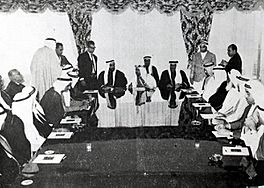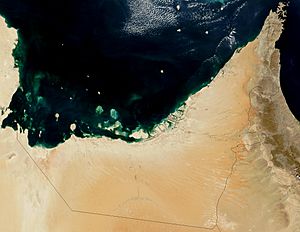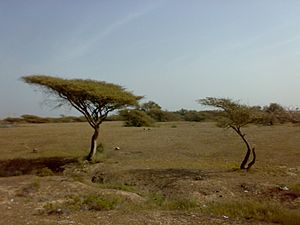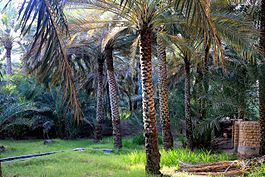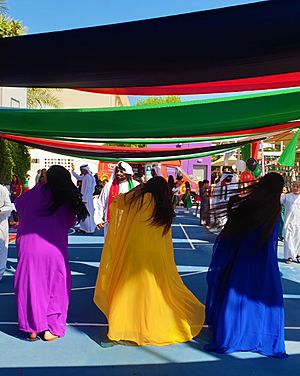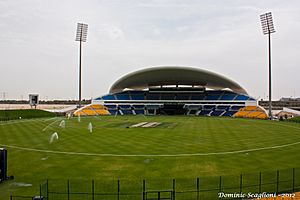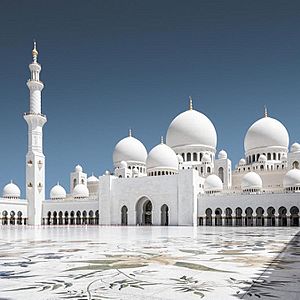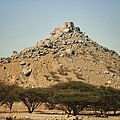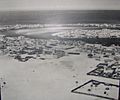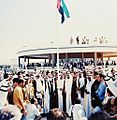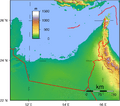United Arab Emirates facts for kids
Quick facts for kids
United Arab Emirates
الإمارات العربية المتحدة
Al-Imārāt al-‘Arabīyah al-Muttaḥidah |
|
|---|---|
|
Motto: الله الوطن الرئيس
"God, Nation, President"
|
|
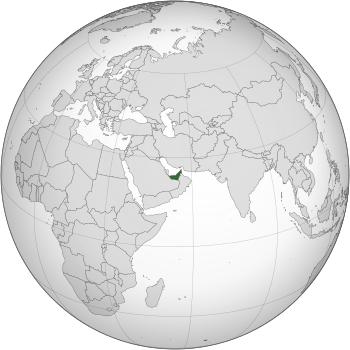
Location of United Arab Emirates (green)
in the Arabian Peninsula |
|
| Capital | Abu Dhabi 24°28′N 54°22′E / 24.467°N 54.367°E |
| Largest city | Dubai 25°15′N 55°18′E / 25.250°N 55.300°E |
| Official languages | Arabic |
| Common languages | Emirati Arabic, English |
| Ethnic groups
(2015)
|
|
| Religion
(2020)
|
|
| Demonym(s) | Emirati |
| Government | Federal Islamic semi-constitutional monarchy |
| Mohamed bin Zayed Al Nahyan | |
| Mohammed bin Rashid Al Maktoum | |
|
• Vice Presidents
|
|
| Legislature |
|
| Establishment | |
|
• British protectorate as part of Persian Gulf Residency
|
1820 and 1892 |
|
• Independence from the United Kingdom
|
2 December 1971 |
|
• Admitted to the United Nations
|
9 December 1971 |
|
• Admission of Ras Al Khaimah
|
10 February 1972 |
| Area | |
|
• Total
|
83,600 km2 (32,300 sq mi) (114th) |
|
• Water (%)
|
negligible |
| Population | |
|
• 2024 estimate
|
11,027,129 |
|
• 2005 census
|
4,106,427 |
|
• Density
|
132/km2 (341.9/sq mi) |
| GDP (PPP) | 2024 estimate |
|
• Total
|
|
|
• Per capita
|
|
| GDP (nominal) | 2024 estimate |
|
• Total
|
|
|
• Per capita
|
|
| Gini (2018) | 26 low |
| HDI (2022) | very high · 17th |
| Currency | UAE dirham (AED) |
| Time zone | UTC+04:00 (GST) |
| Date format | dd/mm/yyyy (AD) |
| Driving side | right |
| Calling code | +971 |
| ISO 3166 code | AE |
| Internet TLD |
|
|
United Arab Emirates portal
|
|
The United Arab Emirates (UAE; Arabic: الإمارات العربية المتحدة al-ʾImārāt al-ʿArabiyah al-Muttaḥidah) is a country in West Asia. It is located at the eastern end of the Arabian Peninsula and shares borders with Oman and Saudi Arabia, while having maritime borders in the Persian Gulf with Qatar and Iran. Abu Dhabi is the nation's capital, while Dubai, the most populous city, is an international hub. As of 2024[update], the UAE has an estimated population of over 10 million.
The United Arab Emirates is an elective monarchy formed from a federation of seven emirates, consisting of Abu Dhabi (the capital), Ajman, Dubai, Fujairah, Ras Al Khaimah, Sharjah and Umm Al Quwain. Each emirate is governed by a ruler and together the rulers form the Federal Supreme Council. The members of the Federal Supreme Council elect a president (as of 14 May 2023, Sheikh Mohamed bin Zayed Al Nahyan) and vice president (Sheikh Mohammed bin Rashid Al Maktoum and Sheikh Mansour bin Zayed Al Nahyan) from among their members. In practice, the ruler of Abu Dhabi serves as president while the ruler of Dubai is vice president and prime minister.
Islam is the official religion and Arabic is the official language. The United Arab Emirates' oil and natural gas reserves are the world's sixth and seventh-largest, respectively. Zayed bin Sultan Al Nahyan, ruler of Abu Dhabi and the country's first president, oversaw the development of the Emirates by investing oil revenues into healthcare, education, and infrastructure. The United Arab Emirates has the most diversified economy among the members of the Gulf Cooperation Council. In the 21st century, the country has become less reliant on oil and gas and is economically focusing on tourism and business. UAE is considered a middle power. It is a member of the United Nations, Arab League, Organisation of Islamic Cooperation, OPEC, Non-Aligned Movement, World Trade Organization and Gulf Cooperation Council (GCC). UAE is a dialogue partner of the Shanghai Cooperation Organization.
Contents
History
The oldest human traces in the Emirates date back to 7000 years BCE. The United Arab Emirates was considered a part of the historical province called "Oman", this place consists of Oman and UAE nowadays. The Emirates has more than 330 historical buildings and cultural sites, some of which have a history from the stone age. After the start of Islam a new chapter began in the area because the new ruling religion of Mekka started to spread, and so was the area of the Arabic gulf one of the first areas where the Muslim missionaries went to. During the Ummayed period, the area of the Arabic Gulf was in a stable situation and it became a global center for navigation and shipping. The Portuguese were the first who arrived in this area after the fall of Al-Andalus and started the discovery of new routes to India without passing the Islamic countries. The explorer Vasco da Gama was the first who could reach India from Europe after turning around the Cape of Good Hope and the could Portuguese controlled all the harbors in the area for more than 2 centuries. During the 18th and 19th centuries could Great Britain controlled the area for political and financial reasons after the Portuguese left.
In 1968 the British announced that they are leaving their colonies in the Middle East and on 2nd December 1971, the United Arab Emirates was created. Zayed bin Sultan Al Nahyan became the president of the state and Rashid bin Saeed Al Maktoum, the ruler of Dubai, became the vice president and so they united 6 Emirates excepting Ras Al Khaimah but it joined the UAE in 1972. After the first president Zayed bin Sultan Al Nahyan, his son Khalifa bin Zayed Al Nahyan became the second president of the UAE. But after his death on the on13th of May 2022, his brother Mohamed bin Zayed Al Nahyan became the 3rd president of the United Arab Emirates.
Government and politics
The United Arab Emirates is a federal constitutional monarchy made up from a federation of seven hereditary tribal monarchy-styled political units called Sheikhdoms. It is governed by a Federal Supreme Council made up of the ruling Sheikhs of Abu Dhabi, Ajman, Fujairah, Sharjah, Dubai, Ras Al Khaimah and Umm Al Quwain. All responsibilities not granted to the federal government are reserved to the individual emirate. A percentage of revenues from each emirate is allocated to the UAE's central budget.
The UAE uses the title Sheikh instead of Emir to refer to the rulers of individual emirates. The title is used due to the sheikhdom styled governing system in adherence to the culture of tribes of Arabia, where Sheikh means leader, elder, or the tribal chief of the clan who partakes in shared decision making with his followers. The president and vice president are elected by the Federal Supreme Council. Usually, the Head of the Al Nahyan family, who are based in Abu Dhabi, holds the presidency and the Head of the Al Maktoum family, based in Dubai, the prime ministership. All prime ministers but one have served concurrently as vice president. The federal government is composed of three branches:
- Legislative: A unicameral Federal Supreme Council and the advisory Federal National Council (FNC).
- Executive: The President, who is also commander-in-chief of the military, the prime minister and the Council of Ministers.
- Judicial: The Supreme Court and lower federal courts.
The UAE e-Government is the extension of the UAE federal government in its electronic form. The UAE's Council of Ministers (Arabic: مجلس الوزراء) is the chief executive branch of the government presided over by the prime minister. The prime minister, who is appointed by the Federal Supreme Council, appoints the ministers. The Council of Ministers is made up of 22 members and manages all internal and foreign affairs of the federation under its constitutional and federal law. In December 2019, the UAE became the only Arab country, and one of only five countries in the world, to attain gender parity in a national legislative body, with its lower house 50 per cent women.
The UAE is the only country in the world that has a Ministry of Tolerance, a Ministry of Happiness, and a Ministry of Artificial Intelligence. The UAE also has a virtual ministry called the Ministry of Possibilities, designed to find solutions to challenges and improve quality of life. The UAE also has a National Youth Council, which is represented in the UAE cabinet by the Minister of Youth.
The UAE legislative body is the Federal National Council which convenes nationwide elections every four years. The FNC consists of 40 members drawn from all the emirates. Each emirate is allocated specific seats to ensure full representation. Half are appointed by the rulers of the constituent emirates, and the other half are elected. By law, the council members have to be equally divided between males and females. The FNC is restricted to a largely consultative role.
Geography
The United Arab Emirates is situated in the Middle East, bordering the Gulf of Oman and the Persian Gulf, between Oman and Saudi Arabia; it is in a location south of the Strait of Hormuz, a transit point for world crude oil.
It lies between 22°30' and 26°10' north latitude and between 51° and 56°25′ east longitude. It shares a 530-kilometre (330 mi) border with Saudi Arabia on the west, south, and southeast, and a 450-kilometre (280 mi) border with Oman on the southeast and northeast. The land border with Qatar in the Khawr al Udayd area is about nineteen kilometres (12 miles) in the northwest; it is a source of border dispute. Following Britain's military departure from UAE in 1971, and its establishment as a new state, UAE laid claim to islands resulting in disputes with Iran that remain unresolved. UAE disputes claim on other islands against the neighboring state of Qatar. The largest emirate, Abu Dhabi, accounts for 87% of the UAE's total area (67,340 square kilometres (26,000 sq mi). The smallest emirate, Ajman, encompasses 259 km2 (100 sq mi).
The coast stretches for nearly 650 km (404 mi) along the southern shore of the Persian Gulf, interrupted by an isolated outcrop of the Sultanate of Oman. 6 of the emirates are situated along the Persian Gulf, and the seventh, Fujairah is on the eastern coast of the peninsula with direct access to the Gulf of Oman. Most of the coast consists of salt pans that extend 8–10 km inland. The largest natural harbor is at Dubai, although other ports have been dredged at Abu Dhabi, Sharjah, and elsewhere. Islands are found in the Persian Gulf, and the ownership of some of them has been the subject of international disputes with both Iran and Qatar. The smaller islands, as well as coral reefs and shifting sandbars, are a menace to navigation. Tides and occasional windstorms further complicate ship movements near the shore. UAE has a stretch of the Al Bāţinah coast of the Gulf of Oman. The Musandam Peninsula, the very tip of Arabia by the Strait of Hormuz, and Madha are exclaves of Oman separated by UAE.

South and west of Abu Dhabi, vast, rolling sand dunes merge into the Rub al-Khali (Empty Quarter) of Saudi Arabia. The desert area of Abu Dhabi includes 2 oases with adequate underground water for permanent settlements and cultivation. The Liwa Oasis is in the south near the undefined border with Saudi Arabia. About 100 km (62 mi) to the northeast of Liwa is the Al-Buraimi oasis, which extends on both sides of the Abu Dhabi-Oman border. Lake Zakher in Al Ain is a human-made lake near the border with Oman that was created from treated waste water.
Biodiversity
The UAE contains the following terrestrial ecoregions: Al Hajar montane woodlands and shrublands, Gulf of Oman desert and semi-desert, and Al-Hajar foothill xeric woodlands and shrublands.
Climate
The climate is subtropical-arid with hot summers and warm winters. The climate is categorized as desert climate. The hottest months are July and August, when average maximum temperatures reach above 45 °C (113 °F) on the coastal plain. In the Hajar Mountains, temperatures are lower, a result of increased elevation. Average minimum temperatures in January and February are between 10 and 14 °C (50 and 57 °F). During the late summer months, a humid southeastern wind known as Sharqi (i.e. "Easterner") makes the coastal region especially unpleasant. The average annual rainfall in the coastal area is less than 120 mm (4.7 in), but in some mountainous areas annual rainfall reaches 350 mm (13.8 in). Rain in the coastal region falls in short, torrential bursts during the winter months, sometimes resulting in floods in ordinarily dry wadi beds.
On 28 December 2004, there was snow recorded in the UAE for the first time, in the Jebel Jais mountain cluster in Ras al-Khaimah. A few years later, there were more sightings of snow and hail. The Jebel Jais mountain cluster has experienced snow twice since records began.
Cities and landscape
This country has seven emirates: Dubai, Ajman, Sharjah, Abu Dhabi ,Umm al-Quwain, Fujairah and Ras Al-Khaimah. It has also more than 200 islands, that differ in size, origin, composition, and importance. The UAE is characterized by a diversity of natural looks from steep mountains to flat coastal plains and from the high red sand dunes in Leoa to the city Al-Ein, which is considered a natural oasis full of palm trees. Al-Ain has relatively low humidity and a temperate climate compared to the other cities in the country.
Largest cities
|
Largest cities or towns in the United Arab Emirates
2023 Calculation |
||
|---|---|---|
| Rank | Name | Pop. |
| 1 | Dubai | 3,564,931 |
| 2 | Abu Dhabi | 1,807,000 |
| 3 | Sharjah | 1,405,000 |
| 4 | Al Ain | 846,747 |
| 5 | Ajman | 490,035 |
| 6 | Ras Al Khaimah | 191,753 |
| 7 | Fujairah | 118,933 |
| 8 | Umm Al Quwain | 59,098 |
| 9 | Khor Fakkan | 53,000 |
| 10 | Kalba | 51,000 |
Tourism
Tourism acts as a growth sector for the entire UAE economy. Dubai is the top tourism destination in the Middle East. According to the annual MasterCard Global Destination Cities Index, Dubai is the fifth most popular tourism destination in the world. Dubai holds up to 66% share of the UAE's tourism economy, with Abu Dhabi having 16% and Sharjah 10%. Dubai welcomed 10 million tourists in 2013.
The UAE has the most advanced and developed infrastructure in the region. Since the 1980s, the UAE has been spending billions of dollars on infrastructure. These developments are particularly evident in the larger emirates of Abu Dhabi and Dubai. The northern emirates are rapidly following suit, providing major incentives for developers of residential and commercial property.
The inbound tourism expenditure in the UAE for 2019 accounted for 118.6 per cent share of the outbound tourism expenditure. Since 6 January 2020, tourist visas to the United Arab Emirates are valid for five years. It has been projected that the travel and tourism industry will contribute about 280.6 billion United Arab Emirati dirham to the UAE's GDP by 2028.
Transport
Dubai International Airport became the busiest airport in the world by international passenger traffic in 2014, overtaking London Heathrow.
Abu Dhabi, Dubai, Sharjah, Ajman, Umm Al Quwain, and Ras Al Khaimah are connected by the E11 highway, which is the longest road in the UAE. In Dubai, in addition to the Dubai Metro, The Dubai Tram and Palm Jumeirah Monorail also connect specific parts of the city. There is also a bus, taxi, abra and water taxi network run by RTA. T1, a double-decker tram system in Downtown Dubai, were operational from 2015 to 2019.
Salik, meaning "open" or "clear", is Dubai's electronic toll collection system that was launched in July 2007 and is part of Dubai's traffic congestion management system. Each time one passes through a Salik tolling point, a toll is deducted from the drivers' prepaid toll account using advanced Radio Frequency Identification (RFID) technology. There are four Salik tolling points placed in strategic locations in Dubai: at Al Maktoum Bridge, Al Garhoud Bridge, and along Sheikh Zayed Road at Al Safa and Al Barsha.

A 1,200 km (750 mi) country-wide railway is under construction which will connect all the major cities and ports. The Dubai Metro is the first urban train network in the Arabian Peninsula.
The major ports of the United Arab Emirates are Khalifa Port, Zayed Port, Port Jebel Ali, Port Rashid, Port Khalid, Port Saeed, and Port Khor Fakkan. The Emirates are increasingly developing their logistics and ports in order to participate in trade between Europe and China or Africa. For this purpose, ports are being rapidly expanded and investments are being made in their technology.
The Emirates have historically been and currently still are part of the Maritime Silk Road that runs from the Chinese coast to the south via the southern tip of India to Mombasa, from there through the Red Sea via the Suez Canal to the Mediterranean, there to the Upper Adriatic region and the northern Italian hub of Trieste with its rail connections to Central Europe, Eastern Europe and the North Sea.
Culture
Emirati culture is based on Arabian culture and has been influenced by the cultures of Persia, India, and East Africa. Arabian and Arabian inspired architecture is part of the expression of the local Emirati identity. Arabian influence on Emirati culture is noticeably visible in traditional Emirati architecture and folk arts. For example, the distinctive wind tower which tops traditional Emirati buildings, the barjeel has become an identifying mark of Emirati architecture and is attributed to Arabian influence. This influence is derived both from traders who fled the tax regime in Persia in the early 19th century and from Emirati ownership of ports on the Arabian coast, for instance the Al Qassimi port of Lingeh.
The United Arab Emirates has a diverse society. Dubai's economy depends more on international trade and tourism, and is more open to visitors, while Abu Dhabi society is more domestic as the city's economy is focused on fossil fuel extraction.
Major holidays in the United Arab Emirates include Eid al Fitr, which marks the end of Ramadan, and National Day (2 December), which marks the formation of the United Arab Emirates. Emirati males prefer to wear a kandura, an ankle-length white tunic woven from wool or cotton, and Emirati women wear an abaya, a black over-garment that covers most parts of the body.
Ancient Emirati poetry was strongly influenced by the eighth-century Arab scholar Al Khalil bin Ahmed. The earliest known poet in the UAE is Ibn Majid, born between 1432 and 1437 in Ras Al-Khaimah. The most famous Emirati writers were Mubarak Al Oqaili (1880–1954), Salem bin Ali al Owais (1887–1959) and Ahmed bin Sulayem (1905–1976). Three other poets from Sharjah, known as the Hirah group, are observed to have been heavily influenced by the Apollo and Romantic poets. The Sharjah International Book Fair is the oldest and largest in the country.
The list of museums in the United Arab Emirates includes some of regional repute, most famously Sharjah with its Heritage District containing 17 museums, which in 1998 was the Cultural Capital of the Arab World. In Dubai, the area of Al Quoz has attracted a number of art galleries as well as museums such as the Salsali Private Museum. Abu Dhabi has established a culture district on Saadiyat Island. Six grand projects are planned, including the Guggenheim Abu Dhabi and the Louvre Abu Dhabi. Dubai also plans to build a Kunsthal museum and a district for galleries and artists.
Emirati culture is a part of the culture of Eastern Arabia. Liwa is a type of music and dance performed locally, mainly in communities that contain descendants of Bantu peoples from the African Great Lakes region. The Dubai Desert Rock Festival is also another major festival consisting of heavy metal and rock artists. The cinema of the United Arab Emirates is minimal but expanding.
Cuisine
The traditional food of the Emirates has always been rice, fish and meat. The people of the United Arab Emirates have adopted most of their foods from other West and South Asian countries including Iran, Saudi Arabia, Pakistan, India and Oman. Seafood has been the mainstay of the Emirati diet for centuries. Meat and rice are other staple foods, with lamb and mutton preferred to goat and beef. Popular beverages are coffee and tea, which can be complemented with cardamom or saffron to give them a distinctive flavour.
Popular cultural Emirati dishes include threed, machboos, khubisa, khameer and chabab bread among others while lugaimat is a famous Emirati dessert.
With the influence of western culture, fast food has become very popular among young people, to the extent that campaigns have been held to highlight the dangers of fast food excesses. Alcohol is allowed to be served only in hotel restaurants and bars. Likewise, pork, which is haram (not permitted for Muslims), is sold in separate sections in all major supermarkets.
Sports
Formula One is particularly popular in the United Arab Emirates, and a Grand Prix is annually held at the Yas Marina Circuit in Yas Island in Abu Dhabi. The race takes place in the evening, and was the first ever Grand Prix to start in daylight and finish at night. Other popular sports include camel racing, falconry, endurance riding, and tennis. The emirate of Dubai is also home to two major golf courses: the Dubai Golf Club and Emirates Golf Club.
In the past, child camel jockeys were used, leading to widespread criticism. Eventually, the UAE passed laws banning the use of children for the sport, leading to the prompt removal of almost all child jockeys. Recently robot jockeys have been introduced to overcome the problem of child camel jockeys which was an issue of human rights violations. Ansar Burney is often praised for the work he has done in this area.
Football
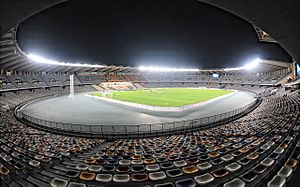
Football is a popular sport in the UAE. Al Nasr, Al Ain, Al Wasl, Sharjah, Al Wahda, and Shabab Al Ahli are the most popular teams and enjoy the reputation of long-time regional champions. The United Arab Emirates Football Association was established in 1971 and since then has dedicated its time and effort to promoting the game, organising youth programmes and improving the abilities of not only its players, but also the officials and coaches involved with its regional teams. The UAE qualified for the FIFA World Cup in 1990, along with Egypt. It was the third consecutive World Cup with two Arab nations qualifying, after Kuwait and Algeria in 1982, and Iraq and Algeria again in 1986. The UAE has won the Gulf Cup Championship twice: the first cup won in January 2007 held in Abu Dhabi and the second in January 2013, held in Bahrain. The country hosted the 2019 AFC Asian Cup. The UAE team went all the way to the semi-finals, where they were defeated by the eventual champions, Qatar.
Cricket
Cricket is one of the most popular sports in the UAE, largely because of the expatriate population from the SAARC countries, the United Kingdom, and Australia. The headquarters of the International Cricket Council (ICC) have been located in the Dubai Sports City complex since 2005, including the ICC Academy which was established in 2009. There are a number of international cricket venues in the UAE, which are frequently used for international tournaments and "neutral" bilateral series due to the local climate and Dubai's status as a transport hub. Notable international tournaments hosted by the UAE have included the 2014 Under-19 Cricket World Cup, the 2021 ICC Men's T20 World Cup, and three editions of the Asia Cup (1984, 1995 and 2018). Notable grounds include the Sharjah Cricket Association Stadium in Sharjah, Sheikh Zayed Cricket Stadium in Abu Dhabi, and Dubai International Cricket Stadium in Dubai.
The Emirates Cricket Board (ECB) became a member of the ICC in 1990. The UAE national cricket team has qualified for the Cricket World Cup on two occasions (1996 and 2015) and the ICC Men's T20 World Cup on one occasion (2014). The national women's team is similarly one of the strongest associate teams in Asia, notably participating in the 2018 ICC Women's World Twenty20 Qualifier.
Following the 2009 attack on the Sri Lanka national cricket team, the UAE served as the de facto home of the Pakistan national cricket team for nearly a decade, as well as hosting the Pakistan Super League. The UAE has also hosted one full edition of Indian Premier League (IPL) in 2020 and two partial editions of the Indian Premier League (IPL) in 2014 and 2021.
Education
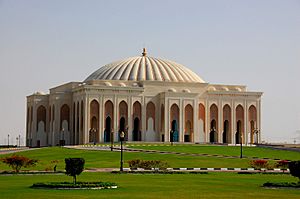
The education system through secondary level administered by the Ministry of Education in all emirates except Abu Dhabi, where it falls under the authority of the Department of Education and Knowledge. Public schools are divided into primary schools, middle schools and high schools. The public schools are government-funded and the curriculum is created to match the United Arab Emirates' development goals. The medium of instruction in the public school is Arabic with emphasis on English as a second language. There are also many private schools which are internationally accredited. Public schools in the country are free for citizens of the UAE, while the fees for private schools vary.
The higher education system is monitored by the Ministry of Higher Education. The ministry also is responsible for admitting students to its undergraduate institutions. The adult literacy rate in 2015 was 93.8%.
The UAE has shown a strong interest in improving education and research. Enterprises include the establishment of the CERT Research Centres and the Masdar Institute of Science and Technology and Institute for Enterprise Development. According to the QS Rankings, the top-ranking universities in the country are the United Arab Emirates University (421–430th worldwide), Khalifa University (441–450th worldwide), the American University of Sharjah (431–440th) and University of Sharjah (551–600th worldwide). United Arab Emirates was ranked 33rd in the Global Innovation Index in 2021, up from 36th in 2019.
Demographics
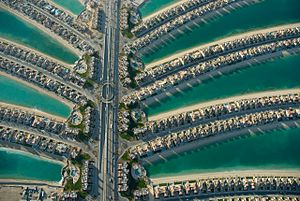
According to an estimate by the World Bank, the UAE's population in 2020 was 9,890,400. Immigrants accounted for 88.52% while Emiratis made up the remaining 11.48%. This unique imbalance is due to the country's exceptionally high net migration rate of 21.71, the world's highest. UAE citizenship is very difficult to obtain other than by filiation and only granted under very special circumstances.
The UAE is ethnically diverse. The five most populous nationalities in the emirates of Dubai, Sharjah, and Ajman are Indian (25%), Pakistani (12%), Emirati (9%), Bangladeshi (7%), and Filipino (5%). Immigrants from Europe, Australia, North America and Latin America make up 500,000 of the population. More than 100,000 British nationals live in the country. The rest of the population are from other Arab states.
About 88% of the population of the United Arab Emirates is urban. The average life expectancy was 76.7 in 2012, higher than for any other Arab country. With a male/female sex ratio of 2.2 males for each female in the total population and 2.75 to 1 for the 15–65 age group, the UAE's gender imbalance is second highest in the world after Qatar.
Religion
Islam is the largest and the official state religion of the UAE. The government follows a policy of tolerance toward other religions and rarely interferes in the religious activities of non-Muslims.
There are more Sunni than Shia Muslims in the United Arab Emirates, and 85% of the Emirati population are Sunni Muslims. The vast majority of the remainder 15% are Shia Muslims, who are concentrated in the Emirates of Dubai and Sharjah. Although no official statistics are available for the breakdown between Sunni and Shia Muslims among noncitizen residents, media estimates suggest less than 20% of the noncitizen Muslim population are Shia. Sheikh Zayed Mosque in Abu Dhabi is the largest mosque in the country and a major tourist attraction. Ibadi is common among Omanis in the UAE, while Sufi influences exist as well.
Christians account for 9% of the total population of the United Arab Emirates, according to the 2005 census; estimates in 2010 suggested a figure of 12.6%. Roman Catholics and Protestants form significant proportions of the Christian minority. The country has over 52 churches in 2023. Many Christians in the United Arab Emirates are of Asian, African, and European origin, along with fellow Middle Eastern countries such as Lebanon, Syria, and Egypt. The United Arab Emirates forms part of the Apostolic Vicariate of Southern Arabia and the Vicar Apostolic Bishop Paul Hinder is based in Abu Dhabi.
There is a small Jewish community in the United Arab Emirates. Before 2023, there was only one known synagogue in Dubai, which has been open since 2008 and the synagogue also welcomes visitors. Another synagogue, Moses Ben Maimon Synagogue was completed in 2023 as part of the Abrahamic Family House complex in Abu Dhabi. As of 2019, according to Rabbi Marc Schneier of the Foundation for Ethnic Understanding, it is estimated that there are about 150 families to 3,000 Jews who live and worship freely in the UAE.
| Religions in UAE in 2010 (Pew Research) | ||||
|---|---|---|---|---|
| Religion | Per cent | |||
| Islam | 76% | |||
| Christianity | 13% | |||
| Hinduism | 7% | |||
| Buddhism | 2% | |||
| Other | 1% | |||
| None | 1% | |||
South Asians in the United Arab Emirates constitute the largest ethnic group in the country. Over 2 million Indian migrants (mostly from the southern states of Kerala, Andhra Pradesh, Coastal Karnataka and Tamil Nadu) are estimated to be living in the UAE. There are currently three Hindu temples in the country. Other religions also exist in the United Arab Emirates, including Jainism, Sikhism, Buddhism, Judaism, Baháʼís and Druze.
The UAE Minister of Foreign Affairs and International Co-operation, Abdullah bin Zayed, announced in 2019 the design and construction plan of the Abrahamic Family House, which will serve as an interfaith complex that houses a synagogue, mosque, and a church on Saadiyat Island in Abu Dhabi.
Languages
Arabic is the national language of the United Arab Emirates. The Gulf dialect of Arabic is spoken natively by Emirati people.
Images for kids
-
2nd century BCE era jar found in Mleiha Archaeological site in Sharjah.
-
A painting of the Portuguese Empire Doba Fortress in Dibba Al-Hisn in 1620.
-
Purple – Portuguese in the Persian Gulf in the 16th and 17th century. Main cities, ports and routes.
-
Dhayah Fort at the hill top. In 1819 it was the last Al-Qasimi stronghold to fall in the Persian Gulf campaign of 1819. The fall of Dhayah was to pave the way for the signing of the General Maritime Treaty of 1820.
-
View of Dubai
-
Roads leading to Jebel Jais, the highest mountain in the UAE (1,892 m), in Ras Al Khaimah.
-
Minister of Foreign Affairs Abdullah bin Zayed Al Nahyan with U.S. Secretary of State Mike Pompeo, 2018.
-
Sheikh Mohammed bin Zayed Al Nahyan and U.S. President Donald Trump in Washington DC, May 2017.
-
Russian president Vladimir Putin meeting with Sheikh Mohammed bin Zayed in Abu Dhabi in October 2019.
-
United Arab Emirates Air Force F-16 Block 60 "Desert Falcon", taking off from the Lockheed Martin plant in Fort Worth, Texas.
-
Two south Asian blue-collar workers posing for a picture with Burj Khalifa on the background.
-
A traditional souk in Deira, Dubai
See also
 In Spanish: Emiratos Árabes Unidos para niños
In Spanish: Emiratos Árabes Unidos para niños




